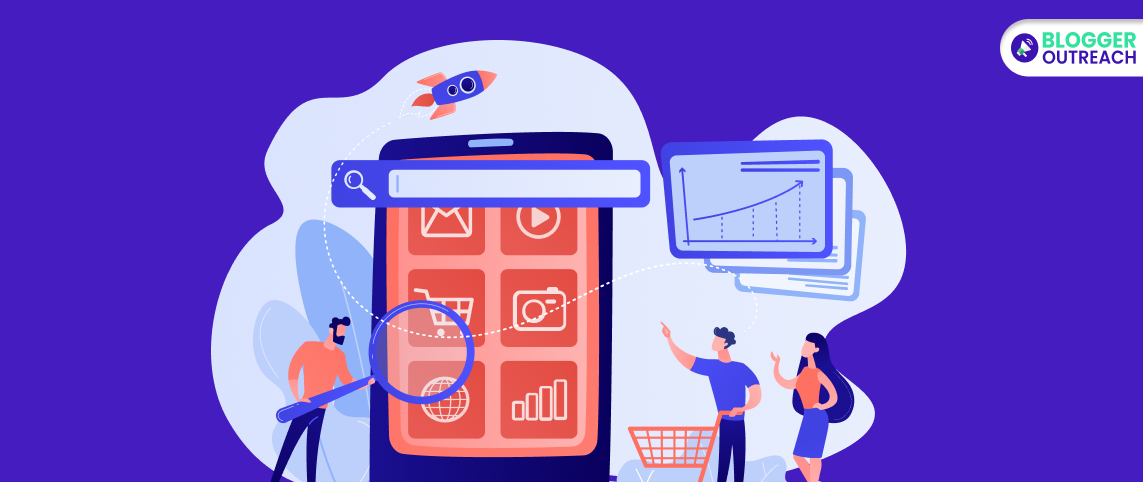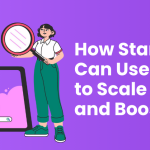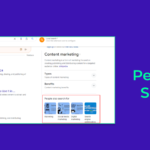Table Of Content
- 1 What Is Ecommerce Digital Marketing?
- 2 Understanding Ecommerce Digital Marketing Funnel
- 3 Consider These 3 Factors Before Devising Your Digital Marketing Plan
- 4 Top 15 Ecommerce Digital Marketing Strategies
- 4.1 1. ✅Search Engine Optimization (SEO)
- 4.2 2. ✅Email Marketing
- 4.3 3. ✅Wishlist Programs – Turning Interest Into Sales
- 4.4 4. ✅Content Marketing
- 4.5 5. ✅Live Chat – The 24/7 Connection
- 4.6 6. ✅Engage And Retain Through Virtual Storefronts
- 4.7 7. ✅Pay-Per-Click (PPC) Advertising
- 4.8 8. ✅User-Generated Content
- 4.9 9. ✅Influencer Marketing
- 4.10 10. ✅Predict Your Sales And Expand Smartly
- 4.11 11. ✅Genrate Leads Through Social Media
- 4.12 12. ✅Abandoned Cart Recovery
- 4.13 13. ✅Learn The Art Of Upselling
- 4.14 14. ✅Think Local – Targeted Delivery
- 4.15 15. ✅Optimize Product Pages: Boost Conversions
- 5 KPIs To Measure The Success Of Ecommerce Digital Marketing
- 6 5 Alarming Mistakes Related To Ecommerce Digital Marketing
- 7 Looking For Inspiration? Check How BloggerOutreach Helped A Sunglass Brand To Attract 138k+ Organic Traffic
Toward the end of 2023, the eCommerce industry will generate $6.3 trillion globally.
In fact, there are more than 26 million ecommerce stores worldwide.
More number of stores = higher revenue = cut-throat competition.
So, how can you stand out and thrive in this competitive digital landscape?
Enter…Ecommerce digital marketing.
Through ecommerce digital marketing – startups, brands, and solopreneurs can take their online visitability to the next level. And this results in more orders!
Before We Go Deep Into This Article, Pay Attention To The Following Statistics:
- Ecommerce brands allocate 10-24% of their budget to SEO and 29-57% to PPC, totaling 39-81%.
- Companies earning around $1 million in revenue invest up to 81% in SEO and PPC.
- For larger brands with a $100 million-plus turnover, 39% of the marketing budget goes to SEO and PPC.
Data speaks! Just look at the importance of ecommerce digital marketing.
Do you want to make the most out of ecommerce digital marketing?
Take a pen and paper, read this article, and make notes out of it.
What Is Ecommerce Digital Marketing?

Ecommerce digital marketing is how online stores promote their products or services. It helps businesses reach more customers on the Internet.
For example, imagine an online clothing store. They use digital marketing to show their clothes to people on social media and search engines. This way, more customers visit their website and buy their products.
So, digital marketing is like online advertising to attract shoppers to online stores. It’s essential for selling things on the internet.
Understanding Ecommerce Digital Marketing Funnel
So, the digital marketing funnel is like a journey…
..from hearing about your store to exploring, thinking, and finally, deciding to buy.
It’s all about guiding people step by step toward becoming your happy customers.
The Ecommerce Digital Marketing Funnel works by first making you aware of their brand, then piquing your interest.
For example, let’s take a brand named “CoolStore,”.
1. Awareness Stage
Imagine you’re on social media and see a post from CoolStore showcasing their stylish men’s clothing.
You hadn’t heard of CoolStore before, but now you know they exist. This is the awareness stage.
2. Interest Stage
You click on CoolStore’s post and visit their website.
You explore their cool collection of men’s clothing, check out some shirts, and maybe even sign up for their newsletter to stay updated.
You’re getting interested in what they offer.
3. Consideration Stage
Over the next few days, you read reviews about CoolStore and compare their prices and styles with other stores.
And you put a few shirts in your online shopping cart. You’re thinking about buying but haven’t made up your mind yet.
4. Decision Stage
Finally, you decide it’s time to update your wardrobe.
You visit CoolStore’s website, enter your details, and buy the awesome shirt you’ve been eyeing.
You’re now a customer of CoolStore.
Consider These 3 Factors Before Devising Your Digital Marketing Plan
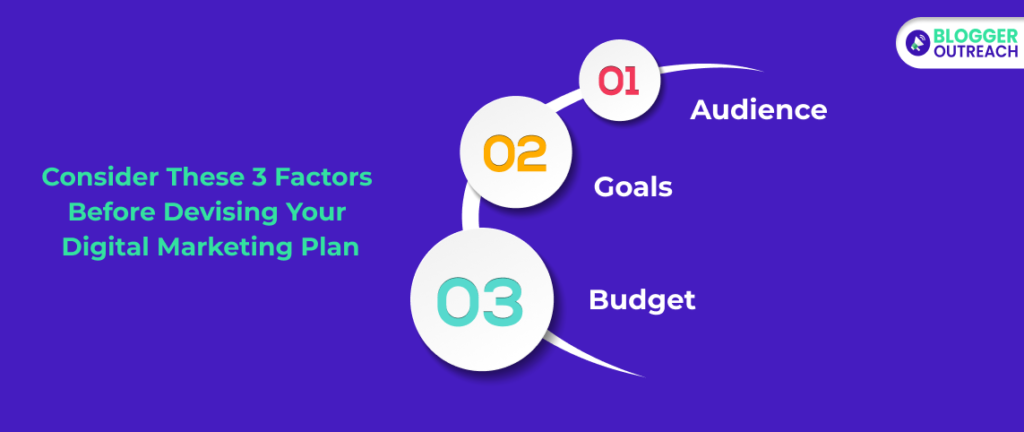
These three factors—Audience, Goals, and Budget—are interrelated and crucial for a successful ecommerce digital marketing plan.
These factors will empower you to make smart decisions.
1. Audience
First, think about who you want to reach with your digital marketing. Your audience includes people interested in your products or services. Knowing them well is vital for success.
- Who is your target audience? Are they young or older, male or female, and what are their interests?
- Where can you find them online? Which social media platforms or websites do they visit?
- What problems or needs do they have? How can your products or services solve them?
- What kind of content do they engage with? Do they prefer videos, blog posts, or images?
- How do they use technology? Are they more mobile users or desktop users?
2. Goals
Set clear objectives for your digital marketing plan.
- What do you want to achieve with your digital marketing efforts? Is it increased website traffic, more sales, or higher brand awareness?
- Are your goals specific, measurable, achievable, relevant, and time-bound (SMART)? Can you track and evaluate your progress?
- How will you measure success? Which key performance indicators (KPIs) will you use to monitor your progress?
- What is your timeline for achieving these goals? Do you have short-term and long-term goals?
3. Budget
Your budget determines how much you can spend on digital marketing. It includes money for ads, content creation, and tools.
- What financial resources are available for your digital marketing plan? How much can you allocate?
- What are the costs associated with your chosen digital marketing channels? Consider ad costs, content creation, and tool subscriptions.
- Do you have a contingency budget for unexpected expenses or experiments?
- How will you distribute your budget among various marketing channels? Will you invest more in social media ads, SEO, or content creation?
Top 15 Ecommerce Digital Marketing Strategies
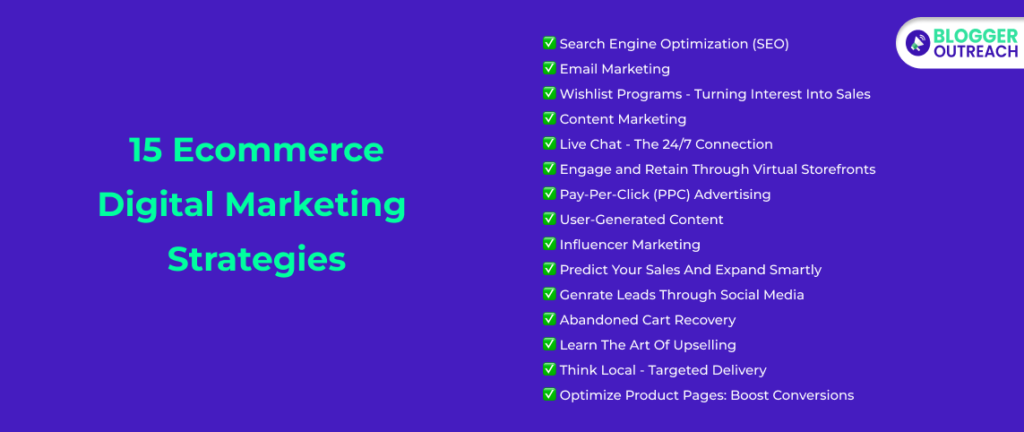
When you implement the following tactics, you can take your online business to new heights.
Remember to keep your content fresh, engage with your audience, and adapt to changing trends.
Your e-commerce venture can thrive in the digital world with persistence and these strategies.
1. ✅Search Engine Optimization (SEO)
Remember, we shared the statistics above. It was about companies spending most of their ecommerce digital marketing budget on SEO.
E-commerce websites rely on SEO as a magic formula. It involves optimizing your website’s content to rank higher in search engine results.
When your online store appears at the top of search results, more people find and visit your website.
Ensure your product descriptions, images, and site structure are SEO-friendly to increase visibility.
2. ✅Email Marketing
Don’t underestimate the power of a well-crafted email.
Collect customer email addresses and send them regular updates, offers, and personalized recommendations.
This keeps your customers informed and reminds them to return and make a purchase. Personalized emails can greatly boost your e-commerce sales.
3. ✅Wishlist Programs – Turning Interest Into Sales
One of the clever ways to boost conversions is by encouraging shoppers to utilize a wishlist feature.
Much like an abandoned cart, a wishlist allows customers to save items they’re interested in.
Here, you should strategically offer incentives, such as discounts or reminders.
Hence, you can nudge them to complete the purchase. It’s a simple yet effective technique to recover potentially lost sales.
4. ✅Content Marketing
High-quality content, such as blog posts, videos, and infographics, can attract visitors to your website and establish your brand as an authority in your niche.
Informative and engaging content keeps your audience engaged. Hence, they come back for more. It’s a long-term strategy that pays off in the end.
5. ✅Live Chat – The 24/7 Connection
Consider incorporating a live chat option on your website to provide your customers with a seamless shopping experience.
This 24/7 availability instils confidence in customers and allows them to seek assistance whenever needed.
Prompt responses to inquiries can significantly affect conversion rates and customer satisfaction.
6. ✅Engage And Retain Through Virtual Storefronts
In the age of online shopping, creating virtual storefronts can provide an engaging and participatory experience for your customers.
These digital spaces replicate the feel of a physical store, making your e-commerce platform more interactive.
The key is to make customers feel like they’re not just shopping but embarking on an enjoyable shopping journey.
7. ✅Pay-Per-Click (PPC) Advertising
PPC advertising allows you to place ads on search engines and other websites, paying only when someone clicks on them.
It’s a great way to get your products in front of potential buyers. Create compelling ad copy and target the right keywords to get the most out of your PPC campaigns.
8. ✅User-Generated Content
Encourage your customers to share their experiences with your products on social media through reviews, photos, or videos.
User-generated content provides social proof and creates a sense of community around your brand. Customers trust the opinions of fellow buyers.
9. ✅Influencer Marketing
Partnering with influencers in your niche can be a game-changer. Influencers have a dedicated following that trusts their recommendations.
Collaborate with relevant influencers to showcase your products and gain exposure to a broader audience. It’s an effective way to boost credibility and sales.
10. ✅Predict Your Sales And Expand Smartly
When considering expanding your product line, analyzing market demand first is crucial.
Gather relevant data, including consumer preferences, trends, and market conditions.
When you do so, you can develop strategies that align with the needs and expectations of your target audience, avoiding unnecessary risks.
11. ✅Genrate Leads Through Social Media
In this era, nearly everyone is on social media. Platforms like Facebook, Instagram, Twitter, and TikTok can be powerful tools for promoting your products.
You can create engaging posts, run targeted ads, and interact with your audience to build brand awareness and trust.
Keep your social media content fresh and relevant, and watch your e-commerce sales grow.
12. ✅Abandoned Cart Recovery
Many online shoppers add items to their carts but don’t complete the purchase.
Implementing an abandoned cart recovery strategy involves sending reminders or incentives to encourage them to return and complete the purchase.
It’s a simple yet effective way to increase your conversion rate.
13. ✅Learn The Art Of Upselling
Upselling is about offering additional products or services that complement the initial purchase.
To succeed in this, ensuring that your upsell suggestions are relevant to the customer’s initial choice and cater to their budget is essential.
A Well-Executed Upselling Strategy Can Significantly Enhance Your Sales In:
- Offering discounts.
- Highlighting product features.
- Demonstrating how a product meets its needs.
14. ✅Think Local – Targeted Delivery
Analyze your customer data to identify areas with a high concentration of consumers.
Consider offering free, reduced, or expedited delivery options to local customers in these areas.
So, align your services with local events, seasons, and consumer behaviour. In turn, you can boost both sales and operational efficiency.
15. ✅Optimize Product Pages: Boost Conversions
Regularly update and refine your product pages to increase on-site conversions and sales.
Conduct research to identify issues and opportunities, and then create and test strategies to determine the most effective sales-boosting techniques.
A seamless and user-friendly online shopping experience can go a long way in retaining customers.
KPIs To Measure The Success Of Ecommerce Digital Marketing
KPIs provide insights into various aspects of your ecommerce digital marketing. Your success will increase if you monitor and analyze them regularly.
🟣Website Traffic: Monitor how many people visit your online store. More traffic often means better visibility.
🟣Conversion Rate: Measure the percentage of visitors who make a purchase. A higher rate indicates more effective marketing.
🟣Average Order Value: This KPI shows how much, on average, customers spend in one order. An increase means more revenue.
🟣Customer Acquisition Cost (CAC): Track how much you spend to gain a new customer. Lower CAC is better for your budget.
🟣Customer Lifetime Value (CLV): This KPI shows the total value a customer brings over their entire relationship with your store. It helps determine long-term profitability.
🟣Cart Abandonment Rate: How often do visitors add items to their cart but leave without buying? Reducing this rate is crucial.
🟣Return On Investment (ROI): Calculate the return you get compared to your marketing investment. A positive ROI is a good sign.
🟣Email Open And Click-Through Rates: Measure how well your email campaigns perform. High open and click rates indicate engaged customers.
🟣Social Media Engagement: Track likes, comments, and shares. High engagement means your audience is interested in your content.
🟣Search Engine Rankings: Monitor where your website appears in search results. Higher rankings mean more visibility.
🟣Customer Satisfaction And Reviews: Happy customers leave positive reviews. They can boost your reputation and attract more buyers.
🟣Abandoned Cart Recovery: Measure how successful your efforts are in convincing customers to return and complete their purchases.
5 Alarming Mistakes Related To Ecommerce Digital Marketing
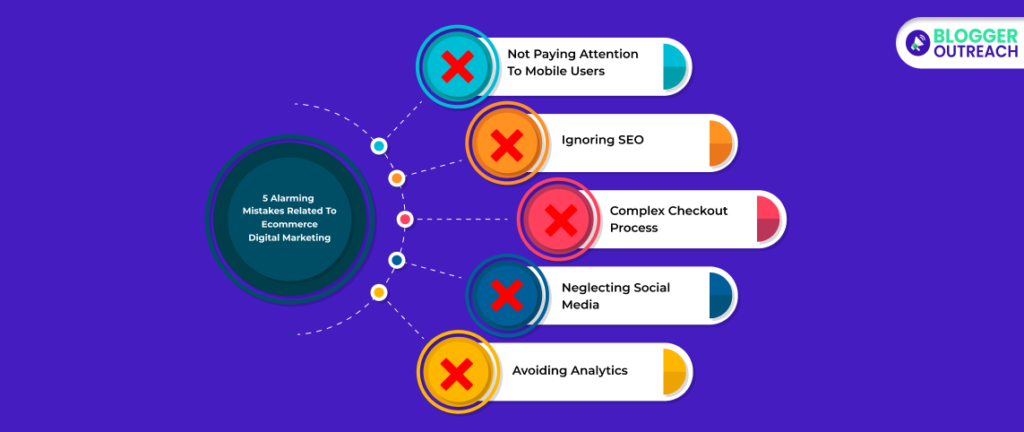
Avoiding these ecommerce digital marketing mistakes can lead to better results and more satisfied customers.
1. ❌Not Paying Attention To Mobile Users
Today, many people use smartphones for shopping. If your website isn’t mobile-friendly, it can be hard to navigate on small screens.
That frustrates potential customers, making them leave and never return.
To avoid this mistake, ensure your website looks and works well on mobile devices.
2. ❌Ignoring SEO
SEO is like the road signs that help customers find your store in the vast online world. If you neglect it, your website might get lost in search engine results.
Use relevant keywords and meta tags to tell search engines what your site is about. This way, more people can discover your products or services.
3. ❌Complex Checkout Process
When customers decide to buy, a complicated and lengthy checkout process can be a deal-breaker.
Imagine you’re in a physical store, and the cashier makes you fill out endless forms and answer many questions before you can pay.
You’d likely abandon your cart and leave. The same applies online. Keep your checkout process simple, with as few steps as possible.
4. ❌Neglecting Social Media
Social media is where people hang out, connect, and discover new things.
If you’re inactive there, you miss a chance to engage with potential customers and show them your products. Share your latest offerings, interact with your audience, and build a loyal following.
5. ❌Avoiding Analytics
You’re in the dark without monitoring how your digital marketing is performing. You might be investing time and money in strategies that don’t work.
Regularly track and analyze your marketing efforts. Look at data like website traffic, conversion rates, and sales. It’ll help you see what’s effective and what needs improvement.
Looking For Inspiration? Check How BloggerOutreach Helped A Sunglass Brand To Attract 138k+ Organic Traffic
Success stories are motivating. They empowered you to take action.
Here is an ecommerce digital marketing success story. With an aim to improve their visibility, they partnered with us.
And as you see above, they garnered a whopping 138k+ organic traffic.
Well, let’s simply say it for you:
Who? Goodr – an online sunglass store.
Problem? They were looking for ways to attract more visitors to their site and get more
sales.
Solution Provided
Organic link insertion strategies with:
- Quality content.
- Natural anchor text placements.
Results:

Want to know more? Check out the complete case study here!
Read Also:

